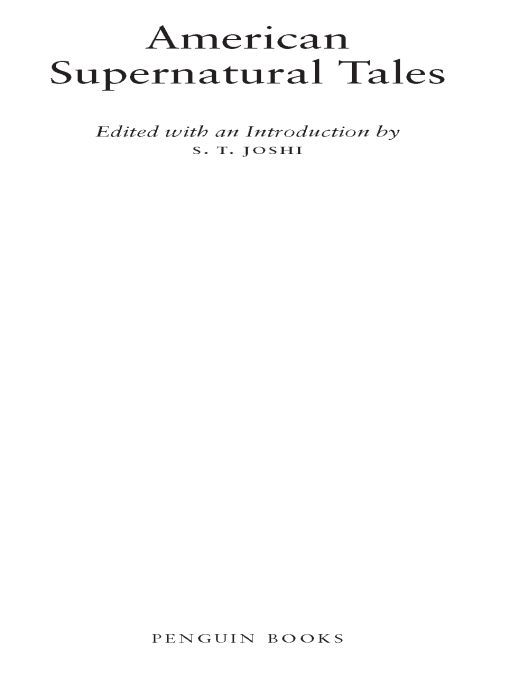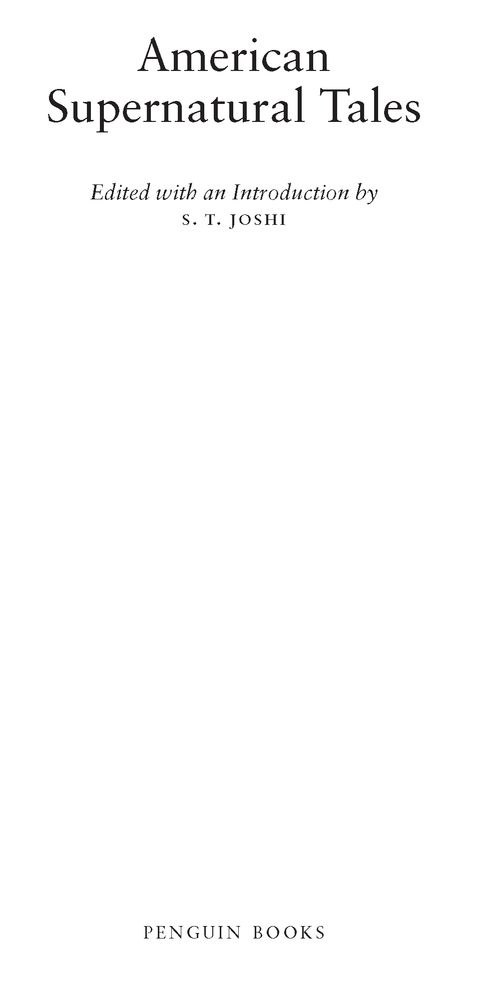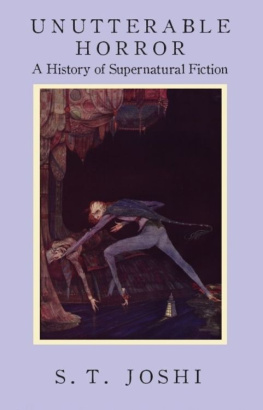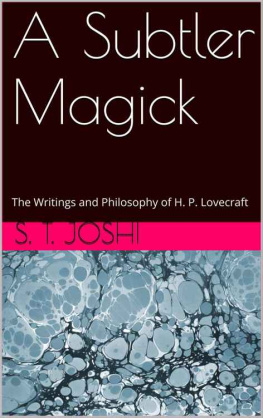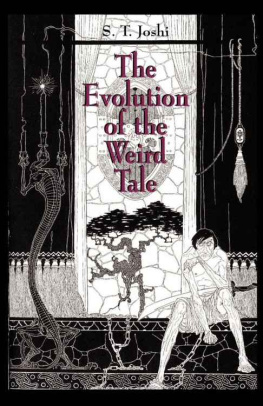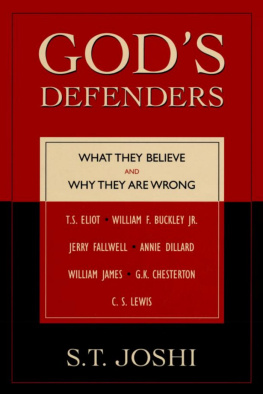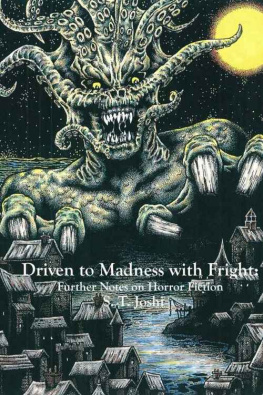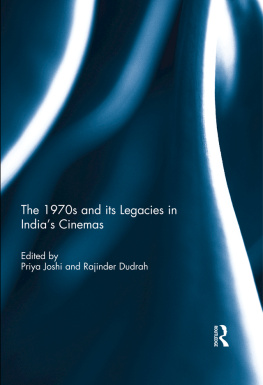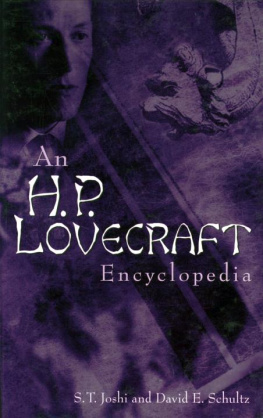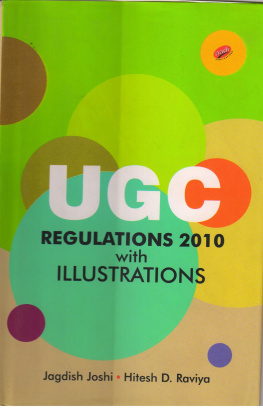Table of Contents
AMERICAN SUPERNATURAL TALES
S. T. JOSHI is a widely published writer and editor. He has edited three Penguin Classics editions of H. P. Lovecrafts horror tales as well as Algernon Blackwoods Ancient Sorceries and Other Strange Stories (2002), Lord Dunsanys In the Land of Time and Other Fantasy Tales (2004), and two volumes of ghost stories by M. R. James (2005, 2006). Among his critical and biographical works are The Weird Tale (1990), H. P. Lovecraft: A Life (1996), and The Modern Weird Tale (2001). He is the coeditor of Supernatural Literature of the World: An Encyclopedia (2005) and the editor of Icons of Horror and the Supernatural (2006). He has edited works by Ambrose Bierce, H. L. Mencken, and other writers. He lives with his wife in upstate New York.
Acknowledgments
The author and publisher are grateful for the following parties for permission to reprint the following copyrighted works:
H. P. Lovecraft, The Call of Cthulhu, copyright 1928 by Popular Fiction Publishing Company. Reprinted by permission of Lovecraft Properties LLC.
Clark Ashton Smith, The Vaults of Yoh-Vombis, copyright 1932 by Popular Fiction Publishing Company. Reprinted by permission of CASiana Literary Enterprises, Inc. and Arkham House Publishers, Inc. and their agents, JABberwocky Literary Agency, P.O. Box 4558, Sunnyside, NY 11104-0558.
Robert E. Howard, Old Garfields Heart, copyright 1933 by Popular Fiction Publishing Company. Reprinted from The Black Stranger and Other American tales by Robert E. Howard, edited and with an introduction by Steven Tompkins, by permission of the University of Nebraska Press. Copyright 2005 by Robert E. Howard Properties, LLC.
Robert Bloch, Black Bargain, copyright 1942 by Popular Fiction Publishing Company. Reprinted by permission of Eleanor Block c/o Ralph M. Vicinanza, Ltd.
August Derleth, The Lonesome Place, copyright 1948. Reprinted by permission of Arkham House Publishers, Inc. and Arkham Houses agents, JABberwocky Literary Agency, P.O. Box 4558, Sunnyside, NY 11104-0558.
Fritz Leiber, The Girl with the Hungry Eyes, copyright 1949 by Avon Books, Inc. Reprinted by permission of Richard Curtis Associates.
Ray Bradbury, The Fog Horn, copyright 1951 by The Curtis Publishing Company, renewed 1979 by Ray Bradbury. Reprinted by permission of Don Congdon Associates, Inc.
Shirley Jackson, A Visit, (also titled The Lovely House), copyright 1952 by Shirley Jackson, from Come Along with Me by Shirley Jackson. Reprinted by permission of Viking Penguin, a division of Penguin Group (USA) Inc.
Richard Matheson, Long Distance Call, copyright 1953 by Galaxy Publishing Corporation, renewed 1981 by Richard Matheson. Reprinted by permission of Don Congdon Associates, Inc.
Charles Beaumont, The Vanishing American, copyright 1955 by Fantasy House, renewed 1983 by Christopher Beaumont. Reprinted by permission of Don Congdon Associates, Inc.
T. E. D. Klein, The Events at Poroth Farm, copyright 1972 by T. E. D. Klein. Reprinted by permission of Pimlico Agency, Inc.
Stephen King, Night Surf, from Night Shift by Stephen King. Copyright 1976, 1977, 1978 by Stephen King. Reprinted by permission of Doubleday, a division of Random House, Inc.
Dennis Etchison, The Late Shift, copyright 1980 by Dennis Etchison. Reprinted by permission of the author.
Thomas Ligotti, Vastarien, copyright 1987 by Thomas Ligotti. Reprinted by permission of the author.
Karl Edward Wagner, Endless Night, copyright 1987 by Karl Edward Wagner. Reprinted by permission of Pimlico Agency, Inc.
Norman Partridge, The Hollow Man, copyright 1991 by Norman Partridge. Reprinted by permission of the author.
David J. Schow, Last Call for the Sons of Shock, copyright 1994 by David J. Schow. Reprinted by permission of the author.
Joyce Carol Oates, Demon, copyright 1996 by Joyce Carol Oates. Reprinted by permission of the author.
Caitlin R. Kiernan, In the Water Works (Birmingham, Alabama 1888), copyright 2000 by Caitlin R. Kiernan. Reprinted by permission of the author.
Introduction
The supernatural in literature can be said to have its roots in the earliest specimens of Western literature, if we take cognizance of such monsters as the Cyclops, the Hydra, Circe, Cerberus, and others in Greek myth. There is, however, a question as to whether, prior to a few centuries ago, such entities would have been regarded as properly supernatural; for a given creature or event to be regarded as supernatural, one must have a clearly defined conception of the natural, from which the supernatural can be regarded as an aberration or departure. In Western culture, the parameters of the natural have been increasingly delimited by science, and it is therefore not surprising that the supernatural, as a distinct literary genre, first emerged in the eighteenth century, when scientific advance had reached a stage where certain phenomena could be recognized as manifestly beyond the bounds of the natural. H. P. Lovecraft, one of the leading theoreticians of the genre as well as one of its pioneering practitioners, emphasized this point somewhat flamboyantly in his essay Supernatural Horror in Literature (1927):
The true weird tale has something more than secret murder, bloody bones, or a sheeted form clanking chains according to rule. A certain atmosphere of breathless and unexplainable dread of outer, unknown forces must be present; and there must be a hint, expressed with a seriousness and portentousness becoming its subject, of that most terrible conception of the human braina malign and particular suspension or defeat of those fixed laws of Nature which are our only safeguard against the assaults of chaos and the daemons of unplumbed space.
What this means is that the supernatural tale, while adhering to the strictest canons of mimetic realism, must have its emotional and aesthetic focus upon the chosen avenue of departure from the naturalwhether it be a creature such as the vampire, the ghost, or the werewolf, or a series of events such as might occur in a haunted house. If all the events of a tale are set in an imaginary realm, then we have crossed over into fantasy, because the contrast between the natural and the supernatural does not come into play. Conversely, the supernatural tale must be clearly distinguished from the tale of psychological horror, where the horror is generated by witnessing the aberrations of a diseased mind. Lovecraft, in discussing William Faulkners tale of necrophilia, A Rose for Emily (1930), made clear this distinction, also pointing out the degree to which the supernatural tale is tied to developments in the sciences:
Manifestly, this is a dark and horrible thing which could happen, whereas the crux of a weird tale is something which could not possibly happen. If any unexpected advance of physics, chemistry, or biology were to indicate the possibility of any phenomena related by the weird tale, that particular set of phenomena would cease to be weird in the ultimate sense because it would become surrounded by a different set of emotions. It would no longer represent imaginative liberation, because it would no longer indicate a suspension or violation of the natural laws against whose universal dominance our fancies rebel. (Letter to August Derleth, November 20, 1931)

